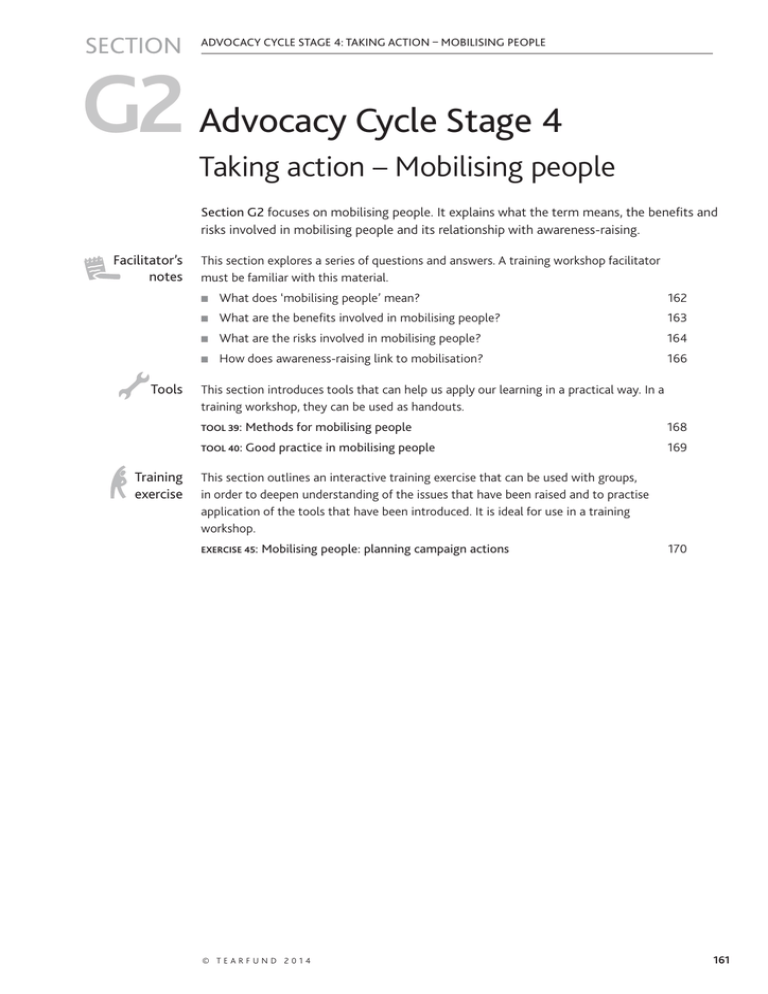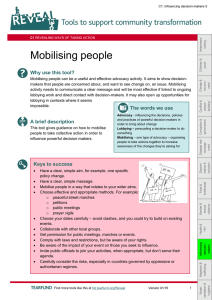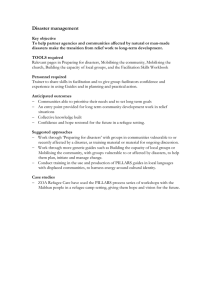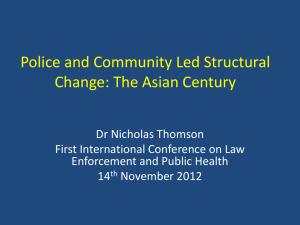G2 Advocacy Cycle Stage 4 Taking action – Mobilising people SECTION
advertisement

SECTION ADVOCACY CYCLE STAGE 4: TAKING ACTION – MOBILISING PEOPLE G2 Advocacy Cycle Stage 4 Taking action – Mobilising people Section G2 focuses on mobilising people. It explains what the term means, the benefits and risks involved in mobilising people and its relationship with awareness-raising. Facilitator’s notes Tools This section explores a series of questions and answers. A training workshop facilitator must be familiar with this material. ■ What does ‘mobilising people’ mean? 162 ■ What are the benefits involved in mobilising people? 163 ■ What are the risks involved in mobilising people? 164 ■ How does awareness-raising link to mobilisation? 166 This section introduces tools that can help us apply our learning in a practical way. In a training workshop, they can be used as handouts. TOOL 39: Methods for mobilising people TOOL 40: Good Training exercise practice in mobilising people 168 169 This section outlines an interactive training exercise that can be used with groups, in order to deepen understanding of the issues that have been raised and to practise application of the tools that have been introduced. It is ideal for use in a training workshop. EXERCISE 45: Mobilising people: planning campaign actions © TEARFUND 2014 170 161 SECTION G2 ROOTS 1 AND 2 ADVOCACY TOOLKIT – PRACTICAL ACTION IN ADVOCACY SECTION G2 Facilitator’s notes What does ‘mobilising people’ mean? ‘Mobilising people’, also called ‘campaigning’, involves enabling people to participate in actions that increase pressure on decision-makers to bring about the changes we are seeking. The aim is to show that people are concerned about the issue and want to see change on the issue. It involves adopting different tactics, requiring different levels of knowledge and commitment according to our advocacy issue and context. While detailed discussions with decision-makers may be taking place in lobbying meetings, most ways of mobilising people or campaign actions are open to anyone. If an action is simple and accessible, there is a greater opportunity for more people to get involved. However, while involving large numbers of people can be effective, it is not always necessary or achievable. There are two types of groups that can be mobilised for action: 1. People who are directly affected by the issue, who can be empowered through taking part. (For example, poor people living in Cochabamba, Bolivia, took part in demonstrations to protest against water privatisation.) 2. People who are concerned for those who are affected by the issue, such as churches, activists and supporters of organisations working on the issue. (For example, in 1991 Tearfund asked supporters in the UK to write to the government of Honduras to support a Tearfund partner called MOPAWI in its campaign against a logging deal. The government had sold a million hectares of rainforest without consulting the indigenous Miskito people who lived there and whose livelihoods and way of life would have been destroyed. In 1992 the campaign succeeded and the government cancelled the deal.) Mobilising or campaigning is culture-specific, perhaps more so than many of the other types of advocacy activities. What works in one country, such as a street march, may not work in another place, where an orderly public meeting might be more appropriate. In some countries, mobilising people publicly is not possible at all, although it can still happen in a virtual way online, through social media and campaign websites, such as through online petitions. Mobilising can involve dozens of possible activities, ranging from prayer vigils to street marches and demonstrations, from postcards and petitions to internet campaigns, from mass lobbying of parliament to boycotts of companies. 162 TEARFUND ROOTS RESOURCES SECTION G2 ADVOCACY CYCLE STAGE 4: TAKING ACTION – MOBILISING PEOPLE Whatever activity we choose, mobilising people should aim to achieve or prevent a specific change relating to our advocacy issue. It should also aim to ‘change the direction of the wind’, by bringing an issue into the public domain and building pressure to tackle it. CAMBODIA CASE STUDY In Cambodia, the government became very concerned about the rapid increase in the ease of access to pornography and explicit materials. This stance was supported by a Tearfund partner and a number of churches, youth groups, women’s groups and others. As a result, the partner launched a campaign to urge the government to change the law, to make it more difficult to access pornography. They started with a street march through Phnom Penh, which received coverage in the local media. This raised awareness about the issue with the general public. It also helped the partner when they talked with the government, encouraging them to act in a stronger way to curb the issue, and when they spoke to churches, urging them to cooperate. For more information, see TOOL 39: Methods for mobilising people. What are the benefits involved in mobilising people? Mobilising people creates opportunities to: ■ Increase pressure on decision-makers by showing there is public concern, a wide range of interested groups and a high level of awareness and understanding of the issue ■ Add legitimacy to lobbying efforts by involving the people affected by the issue ■ Open access to decision-makers if lobbying is not achieving much ■ Use energy or frustration in a positive way that will bring about change ■ Bring media attention to the issue, and raise the profile of the issue ■ Produce greater commitment to the issue by those involved ■ Lobby directly where it has not been possible to lobby before. Sometimes, there is a temptation to organise a march or a protest just to feel like we are doing something, or out of a sense of frustration, even when it is likely to take up a lot of time and is unlikely to bring about significant benefits. At other times, we may be cautious about writing letters or postcards, or signing petitions, in case there are repercussions, yet they can have huge influence on the targets they are aimed at. Engaging and clear messages are vital for encouraging people to take part in the campaign. They usually communicate both a vision of how things should be and a specific ‘campaign ask’ about what should be done to achieve that vision. Mobilising activity that seeks specific changes tends to be most effective. If any mobilising activity does not communicate clear messages, then it is significantly less likely to produce any meaningful change. The message must be striking and memorable, whether it is communicated through letters, postcards, placards, social media or any other method. It should also shape the way people think about the issue. Mobilising people should also be linked to ongoing lobbying work and direct contact with decision-makers. It can also be used to open up opportunities for lobbying, in contexts where it seems impossible. (For example, mobilising people within, and beyond, South Africa led to the government agreeing to negotiate with Nelson Mandela in his prison cell.) Therefore, mobilising people should always connect with wider aims and not just be a freestanding activity. It should be timely and strategic, linked to key moments coming up, such © TEARFUND 2014 163 SECTION G2 ROOTS 1 AND 2 ADVOCACY TOOLKIT – PRACTICAL ACTION IN ADVOCACY as a debate in parliament over legislation, the start of mining activities in a community, or an international conference. The planning of any mobilising activities should take into account key dates and decision-making processes. It should also be agile and able to provide a rapid response to an opportunity if the situation requires it. Mass mobilisation flowchart general public Key decisionmaker organiser affected community CASE STUDY When we can access decision-makers and mobilising people adds to that. When we have to mobilise people because we cannot access decision-makers. BRAZIL ACEV (Açao Evangélica – Evangelical Action), a Tearfund partner in Brazil, drills wells for poor communities and campaigns for access to water for everyone. For several years they campaigned for a pipeline to be run from a reservoir to three different regions. They arranged regular public meetings with parliamentary representatives, the Secretary of State for Water Resources, the head of the state water board, the local mayor and local councillors. Unfortunately, their lobbying was having little success, so they decided to organise a march to demand that the government take responsibility for providing access to clean water and build the pipeline. The politicians thought that few people would take part in the march. However, when they saw that crowds were gathering and television cameras had arrived, they quickly joined the march at the front! This ended in a public meeting, led by ACEV, who carefully controlled the party political balance of speakers. ACEV also organised a petition to the state governor, and paid for adverts on television in favour of the pipeline. Soon after the march, the state governor announced on radio that he would support the start of work on the pipeline. Without the march, this might not have happened. Since then, ACEV has continued to put pressure on the authorities. For more information, see TOOL 40: Good practice in mobilising people. What are the risks involved in mobilising people? In most countries, there are limited dangers associated with mobilising people for mass campaigning actions. In these countries, most actions will be completely peaceful, and have a strong likelihood of gaining media coverage and widespread sympathy and support. However, there are some countries where the risks involved in mobilising people are very high, making it inadvisable as a method of advocacy. Whatever the context, if we are considering mobilising people, it is important to be vigilant and to take any precautions that may be necessary: 164 TEARFUND ROOTS RESOURCES SECTION G2 ADVOCACY CYCLE STAGE 4: TAKING ACTION – MOBILISING PEOPLE Only start mobilising people if it is essential, as it can be more cumbersome and expensive than lobbying and therefore risks wasting time and money. CASE STUDY ■ Select an activity that is appropriate for the context in terms of risk. For example, street marches can be higher risk, while writing letters or sending photos can be lower risk. ■ Work in networks, alliances and coalitions with other groups interested in the issue and with the media. ■ Seek permission from the relevant authorities for any public meetings, marches or events. ■ Find out and keep informed about the relevant laws that permit public activities, the restrictions in place and the rights that protect all citizens, such as the right to peaceful assembly. Seek guidance from lawyers if necessary. ■ Keep a close eye on the media to see if there are any precedents, good or bad. For example, in some countries in Latin America, there have been arbitrary arrests and intimidation tactics towards trade union leaders and community leaders in recent years. ■ Be realistic about what can be achieved. Otherwise, there is a risk that we will be perceived as weak by our targets and potential supporters. ■ Invite public officials to join in activities, when appropriate (including ombudspersons who will have a monitoring role), but be aware of the possibility of being used by public officials for political reasons (co-option). If we let public officials take credit for our advocacy message and/or platform, this should be a tactical decision, not an issue of principle. Our job is to persuade them to do their job better, rather than to support or oppose them, so it can be sensible to ensure that they cannot take credit too easily and that they have to deliver something of value. ZIMBABWE Zimbabwe Orphans through Extended hands (ZOE) is a Tearfund partner that works with orphans and vulnerable children in one of Zimbabwe’s main cities. Many of the children and their families are living with or affected by HIV. During the development of the country’s constitution, ZOE belonged to a coalition of child-focused agencies that worked to ensure that children’s issues were considered and integrated into the development of the constitution. As part of this, they and the other members of the coalition mobilised children and their families to gather in the city centre. While speeches were given by the city councillors and members of the coalition, a mainstream radio station broadcast the event live on air. Everyone then marched to the city hall with a police escort, which was required by law, and the children and their families were given an audience with the city councillors. This gave them the opportunity to ask for their rights to be integrated into the constitution. However, because of government restrictions, they were unable to assess whether or not their requests were taken into account in the constitution development process. For more information, see TOOL 40: Good practice in mobilising people. In countries governed by oppressive or authoritarian regimes, where there are limited rights for public assembly, restrictions on the press and so on, mobilising people for campaigning actions needs to be considered much more carefully in light of all the potential risks (see Sections F2 and G5). If necessary – for example if there is not enough democratic space for mobilising people to take action – other tactics need to be considered, such as encouraging pressure from outside the country through international contacts. © TEARFUND 2014 165 SECTION G2 How does awarenessraising link to mobilisation? ROOTS 1 AND 2 ADVOCACY TOOLKIT – PRACTICAL ACTION IN ADVOCACY Awareness-raising is often the first step in mobilising people to act on a particular issue. Awareness-raising needs to be done with those who are directly affected by the issue, and with others who are concerned for those affected, for example, churches, activists and supporters of organisations working on the issue. If people are not aware of the issue (for example, the fact that people living with HIV are entitled to access antiretroviral drugs, or the fact that a mining company is causing contamination of a river), then they are unlikely to act until such time as they are informed and aware. It is also unfair to expect people to act if they have insufficient information or do not understand the issue. Awareness-raising is therefore essential in order to empower people to act. However, if a church or organisation has raised awareness of an issue, this does not necessarily mean that it has undertaken advocacy! For example, raising awareness in a community of the contamination of a factory and of the laws that exist is not the same as advocating by lobbying the factory and relevant government departments about the need to implement the relevant laws, reduce contamination and provide compensation for the damage caused. In the same way, if we seek to change behaviour, attitudes or lifestyles, we have not necessarily done advocacy. For example, challenging stigma towards people living with HIV is not the same as advocating to the relevant government departments about the need to change the law relating to non-discrimination. Neither is encouraging hand washing the same as advocating for water, sanitation and hygiene for all. Awareness-raising may not lead to advocacy if it simply raises awareness of the poverty and injustice, without helping the community to make the connection between their situation and the decisions and actions of those who have power to change the situation. Awareness-raising therefore needs to include an analysis of the power relations that exist and the ways in which change can come about. It is not advocacy in and of itself. If this is a potential pitfall, it can be useful to talk about ‘awareness-raising for advocacy’. CASE STUDY BRAZIL In Marabá state, in the northern Amazon region of Brazil, sanitation is poor and environmental degradation is high. There are constant floods and no regional refuse collections, and it is common for residents to be affected by diseases related to lack of sanitation. Tearfund partner FALE, a national network of students and young adults, was so concerned about the situation that it decided to launch a national campaign. Together, their members and others engaged with the media to explain the situation, raising awareness among the general public about the extent of the issue, while also making it clear what needed to be done to resolve it. They encouraged people to sign postcards addressed to the relevant authorities, urging government investment in sewage systems and waste disposal management. Members of FALE met with the senator responsible for Marabá state and asked him to persuade the Brazilian National Congress to bring in a new national policy to govern environmental sanitation. At the same time, they put pressure on VALE, a Brazilian mining company, to take responsibility for the environmental damage it was causing in Marabá. As a direct result of the campaign, the government committed to providing an improved water and sanitation network in Marabá, developed a sanitation and environmental plan, and allocated budget to implement it. FALE then continued to lobby the government to deliver its plan and ensure the budget was spent appropriately. 166 TEARFUND ROOTS RESOURCES SECTION G2 ADVOCACY CYCLE STAGE 4: TAKING ACTION – MOBILISING PEOPLE When considering the most appropriate and effective ways of awareness-raising for advocacy, it is important to understand how adults learn. In particular, it has been said that people generally remember: ■ 20% of what they hear ■ 30% of what they see ■ 50% of what they hear and see ■ 80% of what they discover for themselves. Given this, awareness-raising activities should stress learning more than teaching, so that people are encouraged to share their own experiences and understanding with each other, and participate in the planning of any mobilising and campaigning actions. It is also important to recognise that adults learn quickly about things that are concrete and relevant to their lives and 7 that their powers of observation and reasoning often grow stronger over time. One of the best ways that people learn about an issue is when we mobilise them to make lifestyle changes in order to understand and respond to the issue. Examples, depending on our context, include: recycling as much of our litter as possible to promote environmental sustainability; using public transport, cycling or walking, rather than driving private vehicles, in order to reduce our carbon footprint as part of the response to climate change; or buying fairly traded products in order to be part of the solution to global trade issues. Within this dynamic, there is still a clear role for NGOs that have certain technical or political expertise, who can help community members to understand more about the causes, wider context and long-term consequences of the issue they are facing. Useful methods for awareness-raising include: ■ public meetings and rallies ■ information flyers and newsletters ■ radio broadcasts ■ newspaper articles ■ open-air films and slide shows ■ community meetings ■ posters. 7 Adapted from Hope, A, Timmel, S and Hodzi, C (1996) Training for Transformation Book 1, pp.129–131. Mambo Press, Zimbabwe. © TEARFUND 2014 167 HANDOUT TOOL 39 SECTION G2 – ADVOCACY CYCLE STAGE 4: TAKING ACTION – MOBILISING PEOPLE Methods for mobilising people There are many ways to mobilise people for action. Choosing methods should depend on factors such as what people are interested in doing and what will have the greatest impact. The table below outlines a number of options, with some of their benefits and drawbacks. Ways of mobilising people Public meetings How it’s done Benefits Drawbacks People brought together for a debate Might get good publicity Time-consuming and expensive to set up Decision-makers open to public questioning Decision-makers hear views directly Possibility of disruption Chance for discussion Demonstrations, street marches, protests Group of people gathered at a symbolic place to make a visual protest to decision-makers Can be very visual and powerful Possible violence Good media coverage Might lose access to decisionmakers if confrontational Vigils, outdoor church services Group of people gather to make a point about something through a public church activity Peaceful Supporters meeting decision-makers Groups of concerned people meet with decision-makers, often their local officials, to reinforce the message Decision-makers hear directly from those affected Builds local support for campaign Often too many issues included and difficult to coordinate message Marches Group of people walking through the street, possibly with meeting at end and/or symbolic act Visual and fun A lot of effort to organise Easy to participate in for a wide range of people, including children Prone to being hijacked by more extreme groups Unusual actions which draw media attention to your cause, such as street drama Good media attention Can go wrong and look unprofessional People sign a sheet of paper or sign or write a message on a postcard to decision-makers Quick and easy to do Using social networking websites to raise awareness, sending emails, photos or messages to decisionmakers, signing e-petitions Easy to set up Stunts Postcards and petitions Internet campaigns Chance for interviews Engages churches through familiar activities Powerful for getting message across to public and decisionmakers Many people likely to act Difficult to get media engagement Challenging to work with people from other faiths If very controversial, public may be hostile Impersonal, so possibly ignored by decision-makers Can be a good starting point for mobilising the public Free or cheap to do Flexible and responsive Can get many people involved Excludes those without internet access May be ignored because impersonal Letters to decision-makers People write personally to decisionmakers Letters to elected representatives often viewed by policymakers as measure of public concern Harder to do, so may exclude some people Boycotts Refusal to buy products from a certain company Can affect profits and bring pressure for change If few people participate, it will not be effective Good media coverage Potential negative effects on workers 168 ROOTS 1 AND 2 ADVOCACY TOOLKIT © TEARFUND 2014 HANDOUT TOOL 40 SECTION G2 – ADVOCACY CYCLE STAGE 4: TAKING ACTION – MOBILISING PEOPLE Good practice in mobilising people Some general considerations to bear in mind when mobilising groups of people: ■ Include those who are affected by the problem so they take responsibility for advocating for their own issues. For example, if there is contamination by a factory in a village, work with the schools and community groups so that they coordinate and lead a march through the streets. ■ Choose your methods carefully, both according to what will be effective and appropriate, and what people are likely to be willing to do. For example, people may be willing to sign a petition or attend an orderly public meeting, but not to protest outside the factory gates. ■ Have a clear message, knowing what you are asking for, that can be used in a variety of ways eg in radio interviews, placards, posters, slogans. Make it punchy, striking and memorable. Put your issue in context. Link it with wider policy and lobbying work you are doing. ■ Make events fun because this builds solidarity and support. For example, you could hold a carnival or a march. Encourage colour, creativity and variety. ■ Encourage easy actions so that people will readily become involved and act. Many people doing a basic action such as signing a petition can be more powerful than a few people doing a more complicated action such as writing a complex letter. ■ Use novelty and surprise, even in conventional settings such as public meetings, as this engages people with your actions and decision-makers with your demands for change. ■ Maintain momentum by planning several mobilisation tactics or activities ahead of time, and thinking of them as scenarios for use in response to events, rather than as a set sequence. ■ Avoid violence because this will discredit your message and is unlikely to bring about the change you are looking for. It is also against the values of dignity and respect. ■ Think about how the media will respond and plan actions that will attract media attention so you can get your message to a wide audience – for example, visual stunts that provide photo opportunities. ■ Consider the potential effects on your relationship with decision-makers. If you are in discussions with decision-makers about changes that they can make to their policies or practices, then you need to consider whether mobilising people will increase or decrease your chances of success. ■ Work with your allies to reach the widest group of concerned people possible. This may include allies from other countries who could send letters and emails to government officials to show that there is international concern for the issue you are addressing. ■ Identify mobilisers who will get your message out and persuade others to join in with your mobilising actions, such as circulating a petition, bringing friends to a march, etc. Think about who these people are, how you communicate with them and how they communicate with each other, making it as easy as possible for them to get involved. ROOTS 1 AND 2 ADVOCACY TOOLKIT © TEARFUND 2014 169 SECTION G2 ROOTS 1 AND 2 ADVOCACY TOOLKIT – PRACTICAL ACTION IN ADVOCACY SECTION G2 Training exercise EXERCISE 45 Mobilising people: planning campaign actions Aim To gain experience in planning actions that will mobilise people for advocacy TYPE Group exercise TIPS It works best when an advocacy issue has been identified, targets have been identified, and influence mapping has been done (see Sections D and E) METHODS HANDOUTS Small group discussion, plenary discussion TOOL 39: Methods for mobilising people practice in mobilising people TOOL 40: Good STEPS 1. Check that participants have a clear understanding of the advocacy issue they want to see changed, the targets they want to influence, and how those targets could be influenced. 2. Ask participants, based on what they know about the targets, to identify the most appropriate campaign actions for the context. Give out TOOL 39: Methods for mobilising people to help them do this. 3. Once they have selected their methods, ask them to develop a plan to mobilise people to action, using TOOL 40: Good practice in mobilising people. 4. Ask each group (or selected groups) to present their campaigns plan in plenary. The other groups should provide feedback. 5. Lead a plenary discussion around the things that need to be considered when mobilising people, and provide further guidance if required. 170 TEARFUND ROOTS RESOURCES



